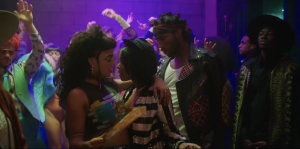Still from Prince’s “Kiss” Music Video, Worldstarhiphop.com
Prince
In the “Kiss” video, Prince also toys with gender and sexuality norms through his extremely androgynous mannerisms. Unlike the “Kiss” singer, many of Prince’s predecessors did not have the same progressive ideas about gender and sexuality as him. Those who rose to fame during the Golden Age of Television, such as Miles Davis and James Brown, are two examples of entertainers who did not share the same views as Prince. Famous trumpet player Miles Davis was known for his overall cool demeanor, but also for his virility and streaks of violence. His “machismo seemed to offer an alternative to the grey-flannel-suit conformity of postwar male identity” (Woodworth 2013, 127). He was revered as a hero in the Black community because he refused to diminish his masculinity to cater to white audiences, though he was still popular with them. In comparison, soul legend James Brown was loud, proud, hypersexual, full of energy and athleticism, and these all showed up in his life and on stage. Like Miles Davis, Brown was also known for his streaks of violence. The concepts of masculinity, hard work, and Black Power, were all inseparable and important to Brown. In regards to his mannerisms, specifically in his music videos, Prince completely strayed from the likes of his predecessors. In the “Kiss” video, Prince constantly sways and rolls his hips, deliberately draws attention to his butt area, purses his lips, and sensually touches himself. Though he displays behavior typically associated with women and femininity, Prince challenges gender and sexuality norms as he interacts with the veiled woman in the video. While displaying feminine mannerisms, Prince takes on a soft, manly role as he kisses and caresses the woman. In some moments, he even stands assertively behind her and in other scenes, leads her in a dance sequence. At certain parts of the video, it is hard to distinguish between Prince and the veiled woman because of their very similar mannerisms. Through this, Prince blurs the lines of gender and sexuality norms. With Prince’s “gender-queering imagery,” he “built his reputation as a sexual provocateur who pushed boundaries of heteronormative gender” (Woodworth 2013, 127). Several scholars have argued that Prince’s androgyny was “empowering, critiquing mainstream ideas about race and gender by disrupting the stereotype of black men as violent, hypermasculine brutes, while at the same time giving black artists more mobility in the mainstream marketplace” (Woodworth 2013, 127). With his mannerisms in videos such as “Kiss,” Prince challenged and redefined these norms of masculinity for Black men.
Still from Janelle Monáe’s “Make Me Feel” Music Video, Thecrimson.com
Janelle Monáe
For Janelle Monáe, her mannerisms in the “Make Me Feel” video, are inspired by Prince in that she displays androgyny in her mannerisms. For the first half of the video, Monáe can be seen touching and flirting with her female love interest, her rumored girlfriend, actress and singer Tessa Thompson. Though dressed in typically feminine sparkly clothing and bright makeup, Monáe challenges a stereotypical equation of femininity and womanhood to heterosexuality, as she has an obvious female love interest. Also, to combat and challenge the equation of femininity to heterosexuality, there are numerous scenes where Monáe is sitting in a chair in a suit, posing in a clear position of dominance and power in comparison to everyone standing in a reverent manner around her. Later in the video, Monáe can be seen rocking and swaying her hips, flirting with her other, male, love interest, and slapping and accentuating her body parts. Again, she complicates these more stereotypical female mannerisms and behaviors by having zoomed in camera shots where she is caressing her female dancers. Whenever Monáe presents a stereotypically male or female mannerism, she is sure to counter it with the opposite of what the audience would expect, which helps her, like Prince, to blur the lines of gender and sexuality norms. In a 2018 interview with New York radio station Hot97’s Ebro Darden, Monáe asserts that she loves her craft because she “gets to define her own message” (Beats 1 2018). She claims that what she does “has always been to redefine how we as young Black women are viewed in America and as entertainers” (Beats 1 2018). She has acknowledged in countless interviews, such as her previously mentioned Rolling Stone interview interviews that Black women in America, even more specifically in entertainment, are not always given the freedom of controlling themselves or their art. With songs and videos such as “Make Me Feel” and the mannerisms she intentionally portrays in them, Monáe is, in many ways, calling for a reclamation of Black women’s gender and sexual power, agency, and control.

